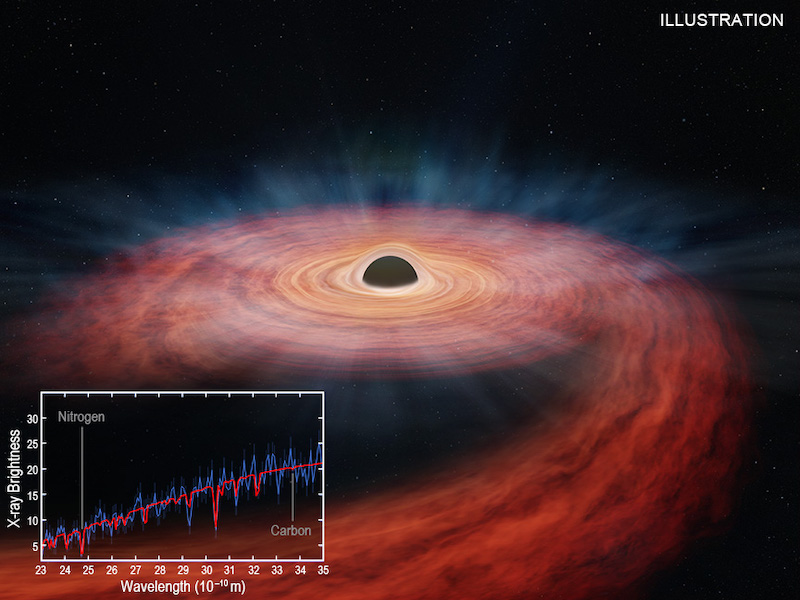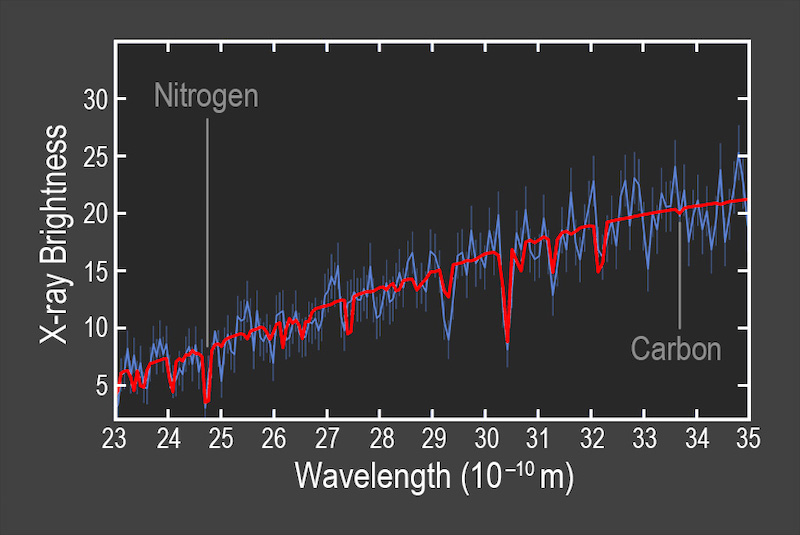
What happens when a star gets too close to a giant black hole? It gets shredded, of course! This month (August 22, 2023), scientists said they’ve completed a forensic study of one such star that met this fate. Telescopes analyzed elements left behind by the star – including nitrogen and carbon – still lingering near the black hole. The researchers said the elements came from inside the star, which literally had its insides ripped out and spewed into space.
The researchers – with NASA’s Chandra X-ray Observatory and ESA’s XMM-Newton space telescopes – published their new peer-reviewed paper in The Astrophysical Journal Letters on August 21, 2023.
When stars come too close
Astronomers call this violent phenomenon a tidal disruption event. Gravitational forces create intense tides that tear the star apart. The trailing part of the resulting stream of gas escapes the system, while the leading part swings back around, surrounding the black hole with a disk of debris. The gravity of a giant black hole is so powerful that even large stars don’t stand much of a chance.
The destruction also causes a flare, which astronomers can see in optical light, ultraviolet light and X-rays. The flare happens as the star’s debris disk is heated up. That is what happened for this particular tidal disruption event in the ASASSN-14li system.
Lead author Jon Miller of the University of Michigan stated:
We are seeing the guts of what used to be a star. The elements left behind are clues we can follow to figure out what sort of star met its demise.
ASASSN-14li was a unique event
The ASASSN-14li event, while similar to other such cataclysms, was also quite notable for a few reasons.
First, astronomers discovered it in November 2014. It was the closest tidal disruption event to Earth recorded in the previous decade, at 290 million light-years. While being the closest such event, it still wasn’t actually “close” to us, per se!
Even though the event was first discovered almost a decade ago, there is still much that scientists can learn from it. Miller and his colleagues used new theoretical models to make improved estimates, as compared to previous studies, of the amount of nitrogen and carbon around the black hole. And indeed, the new analysis has provided a wealth of data about the event. Co-author Brenna Mockler of Carnegie Observatories and the University of California, Los Angeles, said:
These X-ray telescopes can be used as forensic tools in space. The relative amount of nitrogen to carbon that we found points to material from the interior of a doomed star weighing about three times the mass of the sun.
The Hubble Space Telescope previously observed an enhanced amount of nitrogen compared to carbon as well, but by a smaller amount.
One of the most massive stars destroyed by a black hole
This means that ASASSN-14li is one of the most massive – if not the most massive – stars that astronomers have found destroyed by a black hole. Co-author Enrico Ramirez-Ruiz of the University of California, Santa Cruz, added:
ASASSN-14li is exciting because one of the hardest things with tidal disruptions is being able to measure the mass of the unlucky star, as we have done here. Observing the destruction of a massive star by a supermassive black hole is spellbinding because more massive stars are expected to be significantly less common than lower-mass stars.

Future studies
Astronomers can also take what they have learned about ASASSN-14li and apply it to future observations. For example, there is a supermassive black hole in the center of our Milky Way galaxy. It resides within a star cluster that also contains moderately massive stars similar to the one that used to exist in the ASASSN-14li system. Since astronomers can estimate the stellar masses of tidally disrupted stars, they can now detect star clusters around supermassive black holes in the centers of other galaxies as well. Most galaxies are thought to have these giant black holes, just like the Milky Way does.
Astronomers have seen black holes destroy or consume stars multiple times before. You can read more EarthSky stories here.
Bottom line: Scientists have completed a detailed “forensic study” of a massive star destroyed by a giant black hole. The black hole ripped out the insides of the star.
Source: Evidence of a Massive Stellar Disruption in the X-Ray Spectrum of ASASSN-14li
Read more: Astronomers see a star ‘spaghettified’ by a black hole











